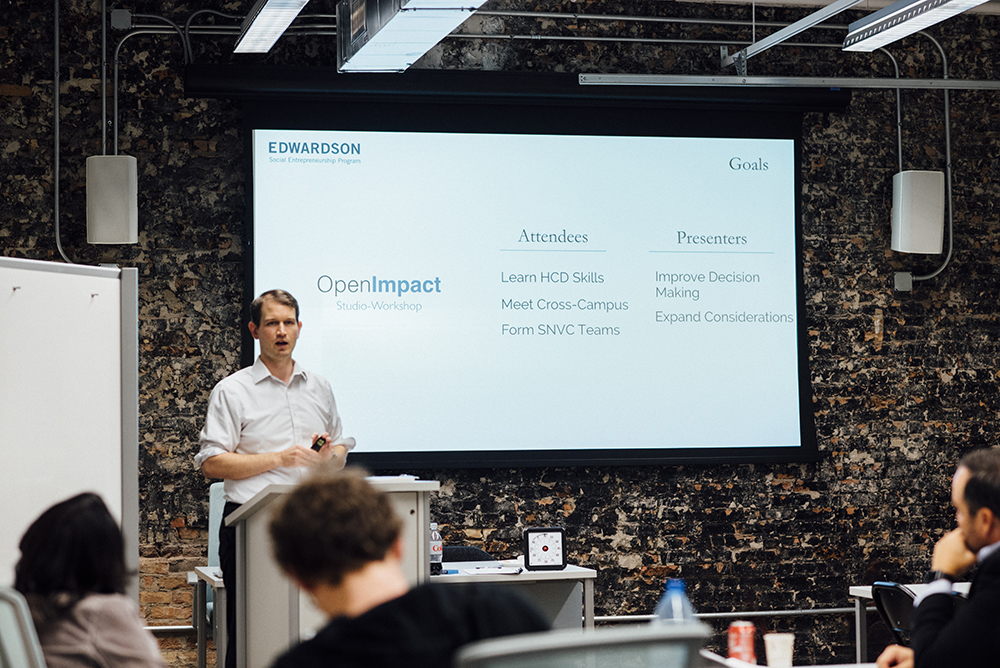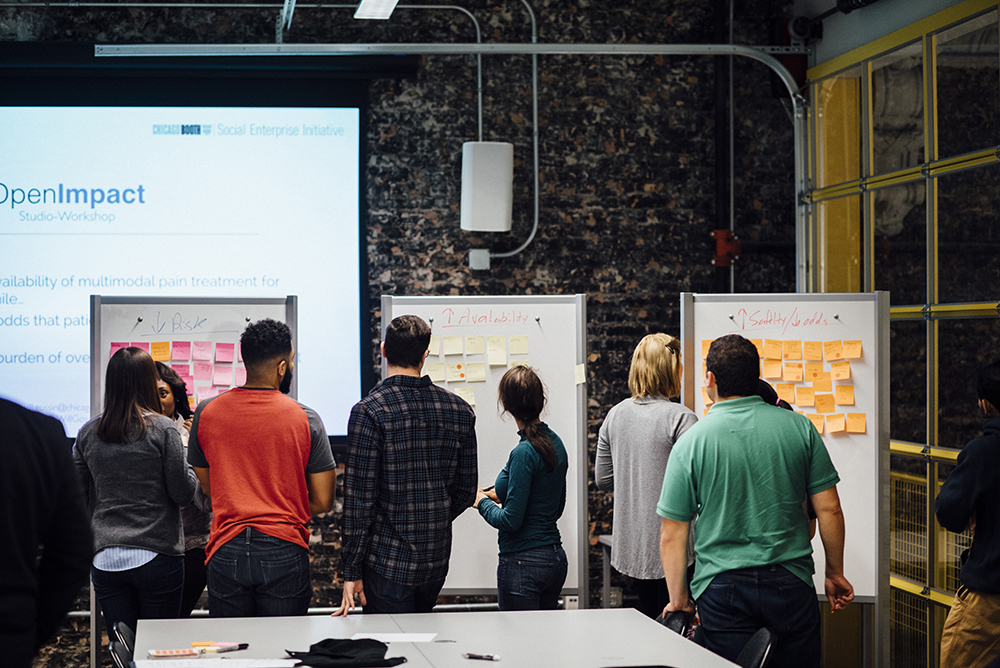Across the social sector, the most promising solutions develop from proximity to on-the-ground problems and access to scientific and operational knowledge. But despite the complementary benefits, there are few reliable mechanisms for uniting research with on-the-ground challenges. The reasons are subtle and structural.
First, traditional commercialization incentives don’t sufficiently compel the consistent transfer of research insights into the numerous geographies where they are needed. The valley of death for this work is wider and more uncharted. Whereas pharmaceutical companies stand ready with a big check to put a geneticist’s research to use, the typical social scientist finds no one at the door.
Second, there’s a misalignment of purpose. When researchers communicate their science, it is primarily to other researchers with the goal of extending a body of knowledge. While the number of faculty exploring the non-academic application of their work is growing--with many exciting examples at University of Chicago and elsewhere -- it is not yet expected of their careers. Taken together, we believe the current activity in this area falls far short of its potential.
In today’s increasingly complex operating context, social sector leaders and social entrepreneurs stand to benefit from faster access to relevant research. For example, an Appalachia-based NGO might realize immediate benefits from new research on: inherited family patterns, early-childhood linguistic development, workers’ responses to incentives, or how political institutions act to protect themselves from change. If social sector leaders could combine this type of scientific knowledge with their operational experience of the evolving reality on the ground, perhaps we would propel our philanthropic dollars further and expand our combined impact.
We, therefore, recognize that there is theoretical demand for new research insights. But the potential value of collaboration is largely unaddressed by the current mechanisms for translating university research to these stakeholders. At Chicago Booth’s Social Enterprise Initiative (SEI), we are working to design new mechanisms to realize that value.
One initial attempt is in a new program called OpenImpact. As part of the Edwardson Social Entrepreneurship Program -- our social innovation pipeline -- OpenImpact is a studio-workshop program. The studio-workshops bring social sector leaders to campus to present operational challenges and collaborate with students and faculty from across research disciplines. In each session, we provide training in foundational entrepreneurship and human-centered design skills with special attention to how we facilitate the group’s productivity. SEI designed OpenImpact to bridge a key gap in the application of research to practice within the social sector. We believe that by collaborating in programs like OpenImpact, both researchers and social sector leaders can accelerate their respective work.
Difficult Collaboration, the Easy Way
Humans have always struggled to collaborate across disciplinary boundaries. In the same way that groups must have argued whether the fastest or strongest hunter should spear the woolly mammoth, we argue whether the marketing or program team will define our fundraising language, or whether the data scientist or designer will make the final call on program implementation. Whenever experts collaborate, they activate issues of trust, communication, methodological value, and often simple comprehension. A misalignment of any of those factors impedes what could otherwise be exceptionally fruitful. Add to this the academic researcher’s sacred right to direct their own research and no wonder the translation of research from universities falls short of its potential in the social sector.
But we see substantial benefits to finding a way for researchers to collaborate more closely with those working across the social sector. What one group takes for granted on a daily basis could be transformative to the other. We believe these mutual benefits represent a high-potential opportunity.
In our early experimentation with OpenImpact, we’ve found two factors that speed both the pleasure and productivity of collaboration: Shared Training and Intense Facilitation. What we have learned can apply equally well to internal collaboration as to future partnerships across the ecosystem.
Beginner’s Mind
We have found that many analytically-minded professionals lack a shared set of concepts and skills in entrepreneurship and human-centered design. Most analytic people seemingly had few occasions to pick-up these skills in their careers, perhaps having been misinformed that they are not rigorous or otherwise “the easy part” of solving a problem. Consequently, these skills represent potent opportunities for creating breakthroughs. We’ve found that teaching these foundational skills in a shared setting yields immediate benefits to a group’s collaborative output.
When experts come together from different disciplines there is nearly always an underlying current of the group working out an implicit hierarchy. In OpenImpact, we flatten the hierarchy by redefining the collaborative space around a new discipline (design and entrepreneurship in this case) so that everyone becomes a first-time learner. Removing the burden of expertise allows participants to suspend the internal negotiation that so many rely on to calibrate their confidence within a group. In the end, productive collaboration depends on a sense that there is permission to contribute -- both officially, and more importantly, as an individual. By creating an environment in which everyone is made equally novice, OpenImpact’s model establishes trust, psychological safety, and common language from the start. With the group poised to freely maximize their inputs, expert facilitation provides the spark to make the collaboration fly.
The Facilitator’s Invisible Hand
After a shared foundation is set, a group’s speed of innovation largely depends on the highly-structured facilitation of collaboration. Participants contribute best when expectations are clear, conflicts of knowledge are quickly resolved, and productive group norms are enforced. When hosting outside presenters in OpenImpact, SEI begins establishing this structure by paying attention to problem definition.
In advance of the workshop, we work with the presenter to narrowly define the problem that they want to engage. In most cases, when an organization first reaches out, they ask for big-picture support --“Can you help me develop a business model,” or “Can you help me better serve our community?” But broad definitions of the problem lead to poor results and even great organizations risk underperformance at this stage.
For instance, a top innovation consultancy once hosted an event, for which the initial problem was framed as: “What is the future of water?” On first consideration, it may seem that by abstracting problems to this level an organization can better make space for non-experts. But counter-intuitively, narrower problem definitions are more conducive to engaging diverse experts in the same task. With a narrower definition -- framed in a human-centered way --participants can more easily draw from their analogous experiences. For example, narrow the water question to something like: “How might we enable more people in rural Africa to drink clean water?” It is now much easier to see it as a transportation problem or as a local extraction, collection, production, or sanitation problem. Each of those may in turn represent a logistics, outsourcing, chemistry, mechanical engineering, or finance problem.
Teams that work from a specifically framed problem compress the time needed to capture the otherwise hidden value of their experience and expertise. Rather than requiring groups to spend time gathering basic knowledge of an opportunity space to arrive at an actionable problem, effective facilitators constrain the group’s initial focus to propel productive creativity.
The Future
This year in OpenImpact, we’ve partnered with organizations across Chicago’s social sector. We’ve run workshops with local nonprofit leaders, a national bank executive, leading faculty, and other universities to create new value and inspire entrepreneurial solutions. The OpenImpact topics were diverse and included: Opioid Abuse in Rural America, Coordination of Care for Pediatric Patients, Prison Recidivism, Inclusive Public Opinion Data, and Workforce Development for Adults on the Autism-spectrum. Next year, we plan to curate a series of thematically linked OpenImpact workshops with additional programming for both researchers and practitioners at Booth’s campuses in Chicago, London, and Hong Kong.
Ultimately, we aim to specialize within with the social sector as a destination for collaboration and learning. We believe that researchers and practitioners gain equally from closer collaboration and that centers like SEI can play an important role. We want to accelerate the application of new knowledge within other organizations while providing our students and faculty access to exciting new questions to explore. We look forward to continuing to partner with organizations, governments, and foundations that share these values, while experimenting with the OpenImpact format to make it more effective as a platform of rich collaboration.




